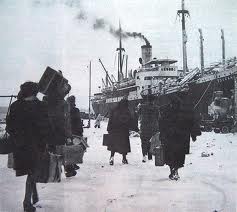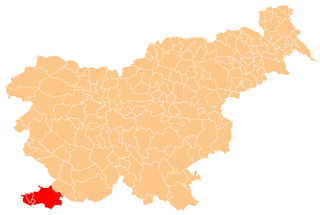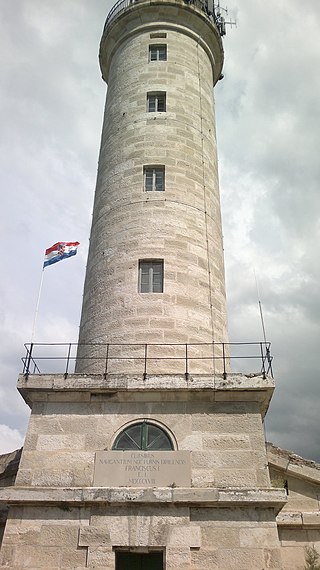
Istria is the largest peninsula within the Adriatic Sea. The peninsula is located at the head of the Adriatic between the Gulf of Trieste and the Kvarner Gulf. It is shared by three countries: Croatia, Slovenia, and Italy, with 90% of surface area being part of Croatia. Croatia encapsulates most of the Istrian peninsula within Istria County.

Poreč is a town and municipality on the western coast of the Istrian peninsula, in Istria County, west Croatia. Its major landmark is the 6th-century Euphrasian Basilica, which was designated a UNESCO World Heritage Site in 1997.

Istria County is the westernmost county of Croatia which includes the biggest part of the Istrian peninsula.

Piran is a town in southwestern Slovenia on the Gulf of Piran on the Adriatic Sea. It is one of the three major towns of Slovenian Istria. The town is known for its medieval architecture, with narrow streets and compact houses. Piran is the administrative seat of the Municipality of Piran and one of Slovenia's major tourist attractions. Until the mid-20th century, Italian was the dominant language, but it was replaced by Slovene following the Istrian exodus.

Umag is a coastal town in Istria, Croatia.

Buje is a town situated in Istria, Croatia's westernmost peninsula.

Novigrad is a town in Istria County in western Croatia. It is also sometimes referred to as Novigrad Istarski to distinguish it from three other Croatian towns of the same name.

Brtonigla is a village and a municipality in the north-western part of Istria County, Croatia. Brtonigla is officially bilingual, with Croatian and Italian being equal; in 2011, 40% of the population declared themselves as ethnic Italians.

Grožnjan is a settlement and municipality in Croatia. It is part of Croatia's Istria County, which takes up most of the Istrian peninsula. 39% of the municipality's population has Italian ethnicity.

Gračišće is a village and municipality of Istria County in Croatia.

Karigador is a village in the Brtonigla municipality in Istria County, Croatia.

The Italian language is an official minority language in Croatia, with many schools and public announcements published in both languages. Croatia's proximity and cultural connections to Italy have led to a relatively large presence of Italians in Croatia. Italians were recognized as a state minority in the Croatian Constitution in two sections: Istrian Italians and Dalmatian Italians. Although only 0.43% of the total population is Italian by citizenship, many more are ethnically Italian and a large percentage of Croatians speak Italian, in addition to Croatian.

The Italian language is an officially recognized minority language in Slovenia, along with Hungarian. Around 3,700 Slovenian citizens speak Italian as their mother tongue, mostly Istrian Italians. Italian has a strong presence in Slovenia, both historical and current. An estimated 15% of Slovenians speak Italian as a second language, which is one of the highest percentages in the European Union.

Slovene Istria is a region in southwest Slovenia. It comprises the northern part of the Istrian peninsula, and it is part of the wider geographical-historical region known as the Slovene Littoral. Its largest urban center is Koper. Other large settlements are Izola, Piran, and Portorož. The entire region has around 120 settlements. In its coastal area, both Slovene and Italian are official languages.
Juricani - historically also Italian: Giurizzani di Materada - is a small village in Croatia. It is officially a part of the city of Umag, which is a coastal city in Istria, Croatia.

Italians of Croatia are an autochthonous historical national minority recognized by the Constitution of Croatia. As such, they elect a special representative to the Croatian Parliament. There is Italian Union of Croatia and Slovenia, in Croat Talijanska Unija, in Slovene Italijanska Unija, which is Croat-Slovene organization with main site in Fiume-Rijeka and secondary site in Capodistria-Koper of Slovenia.

Istria is the largest peninsula in the Adriatic Sea. The peninsula is located at the head of the Adriatic between the Gulf of Trieste and the Bay of Kvarner. It is shared by three countries: Croatia, Slovenia, and Italy.

Bašanija is a naselje (settlement) in the municipality of Umag, Istria County, Croatia. It is the westernmost point of Croatia.

Crveni Vrh is a coastal resort village on Savudrija peninsula in Umag municipality in Istria County, Croatia. It is located on Gulf of Piran with views towards Slovenian towns Portorož and Piran. Crveni Vrh real estate is one of the highest priced in Istria. Srečko Katanec, the former football player and national team manager, owns a villa in Crveni Vrh.
Valica is a village in Umag municipality in Istria County, Croatia.




















